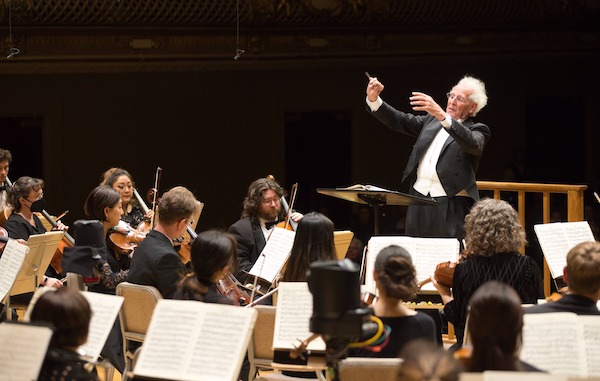Classical Critic’s Notebook: Sergei Rachmaninoff’s Symphony No. 2

Whatever Rachmaninoff’s conflicted feelings about writing symphonies were, there’s nothing ambiguous about the content of his Second Symphony. From start to finish, it’s a marvel of melodic freshness and brilliant instrumentation.
Has any major symphonist exhibited a more ambivalent relationship with the genre than Sergei Rachmaninoff? “When I get it written…I give my solemn word – no more symphonies. Curse them!” he wrote to a friend in April 1907. “I don’t know how to write them, but, mainly, I don’t want to.”
At the time, Rachmaninoff was laboring on his Symphony No. 2, whose January 1908 premiere would be greeted by a degree of acclaim that even took the composer by surprise. But that was all in the future and, given his history with the form, some reticence was understandable.
Indeed, that spring was just a decade removed from the catastrophic unveiling of Rachmaninoff’s Symphony No. 1. The event, which involved an under-prepared orchestra and a possibly-inebriated conductor (the esteemed composer Alexander Glazunov) had been humiliating and nearly destroyed the younger man’s career. It certainly played a part in his subsequent psychological breakdown and three-year withdrawal from writing music (César Cui’s vituperative review, which likened the piece to a depiction of the biblical plagues in Egypt and observed that it might have “delighted the inmates of Hell,” certainly didn’t help Rachmaninoff’s perennially shaky self-confidence).
His return to the compositional arena in 1901, though, was as abrupt as it was vindicating: the November premiere of the C#-minor Piano Concerto No. 2 proved an unequivocal triumph and, within months, Rachmaninoff’s star was firmly in the ascendant.
However, he was now a different composer. In its lush melodic writing and sumptuous orchestration, the Concerto drew rapturous responses from audiences and critics. But its language consciously eschewed the ill-fated 1897 Symphony’s more motivically cryptic and formally daring qualities.
More of the same followed in the Second Symphony, which was written in Dresden in 1906 and ’07. The compositional process was frustrating, no doubt haunted by decade-old memories. Rachmaninoff hated the first draft of the piece, at one point referring to it as “the worst of all.” The process of completing the orchestration was a drag: “The work proceeds very laboriously and sluggishly,” he wrote in August 1907. “If I don’t speed up…the Symphony won’t be complete in less than six months!”
Yet he managed the latter and, after the Second’s first Moscow performance in February 1908 (the world premiere had been in St. Petersburg the previous month), Rachmaninoff was being lionized in the press as “a worthy successor to Tchaikovsky.”
He’d come a long way, yes – but even a favorable notice hinted that the road ahead might not be entirely smooth. “After listening to its four movements,” the leading Muscovite critic Yuli Engel wrote, “one notes with surprise that the hands of the watch have moved sixty-five minutes forward. This may be slightly overlong for the general audience, but how fresh, how beautiful it is!”
The antsy-ness of the masses – and even professional musicians – that Engel perceived emerged soon enough. By the 1920s, the Symphony No. 2 was rarely performed in full. Conductors often made cuts to it and, in the 1930s, Rachmaninoff officially sanctioned excisions of around 300 measures. In at least one instance, the conductor Izlar Solomon’s observation of these omissions and Rachmaninoff’s other edits, coupled with brisk tempos, resulted in a run-time of under forty minutes: the Second was “overlong” no more.
But did that make it better? Rachmaninoff didn’t seem to think so. “You know what the cuts do to me,” he told the conductor Eugene Ormandy shortly before his death in 1943, “it is like cutting out a piece of my heart.” So why did he accede to such drastic changes?
The answer is, in part, painfully simple: Rachmaninoff wanted the music performed and he was willing to do anything to get that to happen. Though he went on record saying he’d rather have the Symphony played without cuts, among his contemporaries only Leopold Stokowski took him at his word.
Other factors were in play, too. The composer’s flight from revolutionary Russia cast a dark shadow over the last quarter-century of his life: “Losing my country I lost myself also…there remains no desire for self-expression,” he once observed.
Concertizing restored his family’s finances but, for a time, composition fell off. Then the failure of the Piano Concerto No. 4 in 1927 threatened a relapse of the depression that had derailed Rachmaninoff’s early career. That was staved off by writing the Variations on a Theme of Corelli; a couple of years later, the Rhapsody on a Theme of Paganini proved a final, public mega-hit. Even so, Rachmaninoff in the ‘30s was a melancholy shadow of his former self.
Thus, various edited versions of the Second proliferated. It wasn’t until 1972 that André Previn, touring with the piece through the Soviet Union, was told that Rachmaninoff only actually liked one small cut in the finale. Having reconsidered his approach, Previn subsequently recorded the full score with the London Symphony. This both gave the composer’s stated preference its due and helped finally end the practice of bowdlerizing the Symphony. Now the work is nearly only performed complete.

Benjamin Zander conducts the Boston Philharmonic for Rachmaninoff Symphony No. 2. Photo: Hilary Scott.
Whatever Rachmaninoff’s conflicted feelings about writing symphonies were, there’s nothing ambiguous about the content of his Second Symphony. From start to finish, it’s a marvel of melodic freshness and brilliant instrumentation. Whether or not the piece fulfils one of the composer’s definitions of music as representing “Love,” it certainly confirms his view that the art is “the Sister of Poetry and her Mother is Sorrow.”
Its big, brooding first movement picks up in the depths, right where Tchaikovsky’s Pathétique Symphony left off fifteen years prior (it even starts on the same note: B natural). The second is a diabolical Scherzo whose echoes of the Medieval Dies irae plainchant would become one of Rachmaninoff’s trademarks, while the Adagio stands among the most radiant essays in the Western symphonic canon. In the finale, boisterous, dancing figures alternate with soaring melodic lines and any hint of darkness is decisively banished in the final, iridescent dash to the double-bar.
To some degree, the piece plays itself, though it takes a clear-headed advocate to keep the proceedings focused and from lapsing into excess. On Wednesday night at Symphony Hall, it had just that in Benjamin Zander and the Boston Philharmonic Orchestra (BPO), which capped the first concert of their 44th season (and Zander’s 50th as a conductor) with a lucid, impassioned account of the Rachmaninoff Symphony No. 2.
Theirs was, fundamentally, a lyrical interpretation. True, this aspect is built into much of the music. Still, on Wednesday, Zander ensured that even its stricter bits – like the first movement’s stormy climaxes and the Scherzo’s fugal episode – sang.
He also managed to avoid over-sentimentalizing the proceedings. This was partly a matter of tempo, especially in the Adagio, which always moved smartly but never insistently. A bevy of glowing solos – including those from principal clarinet Rane Moore, principal oboe Nancy Dimock, and English hornist Andrew van der Paardt – were only an extension of the larger BPO’s wonderfully discreet ensemble playing in that movement.
And the score’s bold moments, though they weren’t always aggressive, rarely wanted for tonal presence or weight. The BPO’s brass section (especially the horns) played with exemplary power and finesse in the second and fourth movements. Textures in busy spots, especially the finale, were cleanly balanced. As a result, a host of instrumental details and motivic relationships between the movements came through. This was, for certain, some conspicuously rousing, meaningful Rachmaninoff.
Winning as the interpretation was on its own, it was enhanced by smart programming: the night’s first half belonged to Beethoven’s Piano Concerto No. 4.

Benjamin Zander conducts Beethoven’s Piano Concerto No. 4 with Jonathan Biss on piano. Photo: Hilary Scott
Wednesday’s performance, which showcased the exceptional pianist Jonathan Biss, highlighted that score’s Classical restraint. Tempos were a touch stately, though they never failed to move forwards. Throughout, the Concerto’s poetic qualities (especially the Andante’s transition from violence to peace) anticipated the same in the Rachmaninoff.
Biss, playing with pearly tone, impeccable balances, and a complete understanding of Beethovenian style, was unforgettable it the short middle movement. He also let loose with fire in the outer-movement cadenzas. An encore of the Bagatelle Op. 126, No. 1 – three minutes of searching, songful beauty, flawlessly played – provided a perfect bridge into the night’s second half.
In the Concerto, Zander drew playing of warmth and, occasionally, ear-catching plushness from his forces. Period-practice Beethoven this may not have been, but when a performance is as richly blended and characterfully true as this one, that’s no loss.
It certainly enhanced what came after intermission. To an even greater degree than the Beethoven, the Rachmaninoff reading was one in which the listener could simply – and gloriously – get lost in the music. The wonder of it had less to do with the Symphony’s size and duration than with the realization that this familiar, hour-long score could be so persistently and consistently packed with invention.
Insecurities about the genre aside, Rachmaninoff, as Zander and Friends reminded us, had been right about this piece all along.
 Jonathan Blumhofer - The Arts Fuse
Jonathan Blumhofer - The Arts Fuse